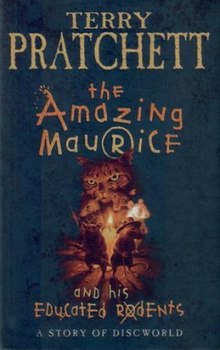
Rats are various medium-sized, long-tailed rodents. Species of rats are found throughout the order Rodentia, but stereotypical rats are found in the genus Rattus. Other rat genera include Neotoma, Bandicota and Dipodomys.

Sir Terence David John Pratchett was an English author, humorist, and satirist, best known for his 41 comic fantasy novels set on the Discworld, and for the apocalyptic comedy novel Good Omens (1990) which he wrote with Neil Gaiman.
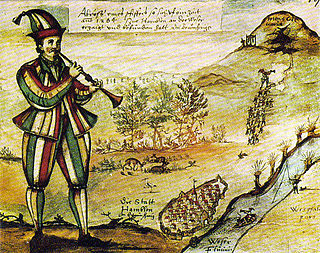
The Pied Piper of Hamelin is the title character of a legend from the town of Hamelin (Hameln), Lower Saxony, Germany.

The Wee Free Men is a 2003 comic fantasy novel by British writer Terry Pratchett, which takes place in his Discworld setting. It is labelled a "Story of Discworld" to indicate its status as children's or young adult fiction, unlike most of the books in the Discworld series. A sequel, A Hat Full of Sky, appeared in 2004 ; a third book called Wintersmith appeared in 2006; and the fourth, I Shall Wear Midnight, was released in September 2010. The final book in the series, The Shepherd's Crown, was released in 2015.

The Colour of Magic is a 1983 fantasy comedy novel by Terry Pratchett, and is the first book of the Discworld series. The first printing of the British edition consisted of only 506 copies. Pratchett has described it as "an attempt to do for the classical fantasy universe what Blazing Saddles did for Westerns."
Stephen Briggs is a British writer of subsidiary works and merchandise surrounding Terry Pratchett's comic fantasy Discworld. The Streets of Ankh-Morpork, the first Discworld map, was co-designed by Briggs and Pratchett and painted by Stephen Player in 1993. This was followed by The Discworld Mapp (1995), also painted by Stephen Player, and A Tourist Guide to Lancre (1998), painted by Paul Kidby.
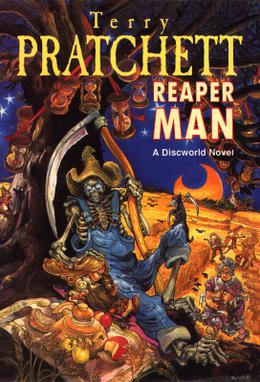
Reaper Man is a fantasy novel by British writer Terry Pratchett. Published in 1991, it is the 11th Discworld novel and the second to focus on Death. The title is a reference to Alex Cox's movie Repo Man.

A rat king is a collection of rats or mice whose tails are intertwined and bound together in some way. This could be a result of an entangling material like hair, a sticky substance such as sap or gum, or the tails being tied together.
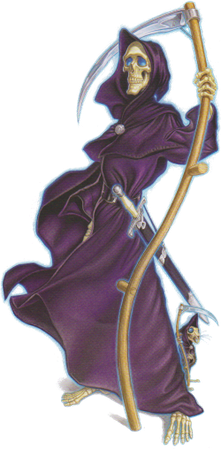
Death is a fictional character in Terry Pratchett's Discworld series and a parody of several other depictions of the Grim Reaper. He is a black-robed skeleton who usually carries a scythe. His jurisdiction is specifically the Discworld itself; he is only a minion of Azrael, the universal Death. Pratchett explores human existence through his depiction of death, which became more sympathetic throughout the series.
The Ankh-Morpork City Watch is the police force of the fictional city of Ankh-Morpork in the Discworld series by the English writer Terry Pratchett.
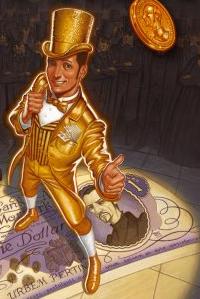
Moist von Lipwig is a fictional character from Terry Pratchett's Discworld series. A "reformed con-man" who is one of the major characters of the series, von Lipwig is the protagonist of the novels Going Postal, Making Money, and Raising Steam.

The Muridae, or murids, are either the largest or second-largest family of rodents and of mammals, containing approximately 870 species, including many species of mice, rats, and gerbils found naturally throughout Eurasia, Africa, and Australia.
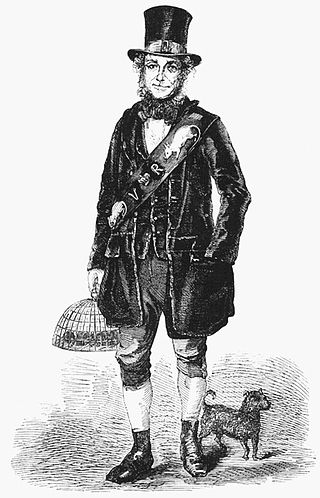
A rat-catcher is a person who kills or captures rats as a professional form of pest control. Keeping the rat population under control was practiced in Europe to prevent the spread of diseases, most notoriously the Black Death, and to prevent damage to food supplies. In modern developed countries, such a professional is otherwise known as a pest control operative or pest exterminator.

Where's My Cow? is a picture book written by Terry Pratchett and illustrated by Melvyn Grant. It is based on a book that features in Pratchett's Discworld novel Thud!, in which Samuel Vimes reads it to his son.

Terry Pratchett's Hogfather is a 2006 two-part British Christmas-themed fantasy comedy television miniseries adaptation of Hogfather by Terry Pratchett, produced by The Mob, and first broadcast on Sky1, and in High Definition on Sky1 HD, over Christmas 2006. First aired in two 1.5-hour episodes on 17 and 18 December 2006 at 20:00 UTC, it was the first live-action film adaptation of a Discworld novel. In 2007, the two episodes were rerun on Christmas Eve and Christmas Day respectively on Sky One and Sky1 HD.

Ankh-Morpork is a fictional city-state that is the setting for many Discworld novels by Terry Pratchett.

Discworld is a comic fantasy book series written by the English author Terry Pratchett, set on the Discworld, a flat planet balanced on the backs of four elephants which in turn stand on the back of a giant turtle. The series began in 1983 with The Colour of Magic and continued until the final novel The Shepherd's Crown, which was published in 2015, following Pratchett's death. The books frequently parody or take inspiration from classic works, usually fantasy or science fiction, as well as mythology, folklore and fairy tales, and often use them for satirical parallels with cultural, political and scientific issues.
In the fictional world of Terry Pratchett's Discworld series of novels, the Nac Mac Feegle are a type of fairy folk. They appear in the novels Carpe Jugulum, The Wee Free Men, A Hat Full of Sky, Wintersmith, I Shall Wear Midnight, Snuff and The Shepherd's Crown. At six inches tall, they are seen as occasionally helpful thieves and pests.

The Amazing Maurice is a 2022 animated fantasy comedy film directed by Toby Genkel and co-directed by Florian Westermann, from a screenplay by Terry Rossio, based on the 2001 novel The Amazing Maurice and His Educated Rodents by Terry Pratchett. The film stars Hugh Laurie, Emilia Clarke, David Thewlis, Himesh Patel, Gemma Arterton, Joe Sugg, Ariyon Bakare, Julie Atherton, Rob Brydon, Hugh Bonneville and David Tennant. The story follows Maurice, a streetwise ginger cat who befriends a group of talking rats by coming up with a money-making scam.
